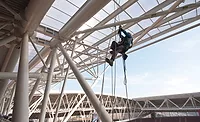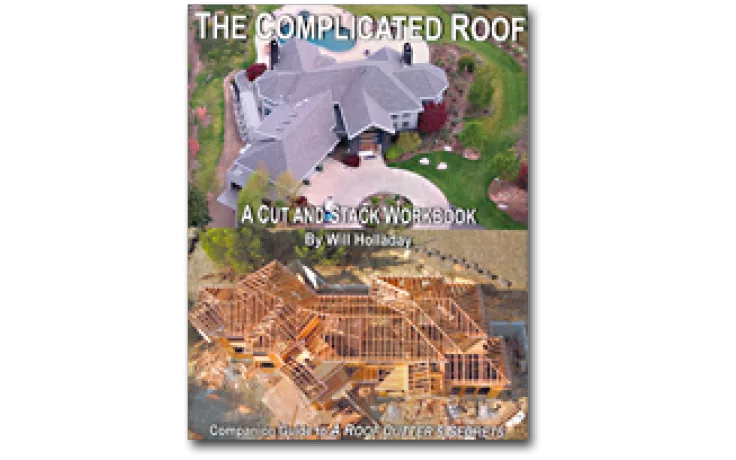Demonstrating the Need for a Variance
On Feb. 15, the Occupational Safety and Health Administration (OSHA) announced that it was extending the date for temporary enforcement measures for residential construction through Sept.15, 2012. The temporary measures include priority free on-site compliance assistance, penalty reductions, extended abatement dates, measures to assure consistency, and increased outreach regarding STD 03-11-002 (Compliance Guidance for Residential Construction). STD 03-11-002 is the directive that went into effect June 16, 2011. It rescinded the previous interim enforcement policy (STD 03-00-001) on fall protection for specified residential construction activities, replacing it with a new set of guidelines for OSHA compliance officers. Under the old guidelines, residential construction workers were allowed to use alternative methods (such as slide guards or safety monitoring systems) to protect themselves from fall hazards. The new guidelines rescinded those exceptions, meaning that in most cases personal fall arrest systems, guardrails or safety nets must be used on residential jobsites — if infeasibility or greater hazard variances are not obtainable.
To say that after the new guidelines were announced there then ensued a nationwide storm of controversy among many residential contractors, contractor/builder associations and the agency itself would be an understatement. The crux of the residential contractors’ arguments against rescinding the old policy appears to balance upon the difficulty in obtaining OSHA’s permission to use “alternative fall protection measures” from an OSHA site inspector by claiming a variance to their compliance with 29 CFR 1926.501(b)(13), Residential Construction, and 1926.502(k), Fall Protection Plan. OSHA continues to defend its position that there isn’t enough “persuasive evidence” that contractor compliance with Subpart M, Fall Protection, “is infeasible or presents significant safety hazards.”
But just what is a variance and how does a contractor demonstrate the need for one in cases where fall protection measures are infeasible or pose a safety hazard?
Standard Variance
Under the OSH Act of 1970, a Standard Temporary Variance is an exception to a specific 29 CFR compliance standard which has been permitted by OSHA on the local Area Office level to an employer who has applied for and proven, beyond any reasonable doubt, that he can protect his employees within a particular controlled access zone for a specific time frame or during a task-specific operation. There are four basic types of legal variances available to employers by area and regional OSHA offices:
1. Temporary variance: The most common form of variance, a temporary variance allows an employer a short window of time in which he may perform acceptable, alternate methods of protection, such as depicted in a fall protection plan. Complete application procedures are listed in 29 CFR 1905.10, Subpart B. This is the variance procedure most contractors choose when either (1) they cannot feasibly complete a project within allotted contract time; or (2) the technology required to achieve standard compliance is “temporarily unavailable.” The excessive cost to comply with standard-approved methods of hazard abatement is not considered a defensible criteria for application. The employer’s alternate and equal methods of employee protection, described in his fall protection plan, must be submitted with his application, along with a sworn statement guaranteeing immediate implementation if approved by the agency. The employer may also apply for an interim order allowing him to “operate under existing conditions” while awaiting OSHA’s approval or denial of his application. Otherwise, any time during the approval process, the employer must either provide standard fall protection measures or suspend any tasks that potentially expose his employees to a fall from the standard-prescribed trigger heights. A hard copy of OSHA’s temporary variance shall be conspicuously posted on the worksite, giving notification to the employee’s representative, who is specifically designated in the order of variance.
2. Permanent variance: This less-common exemption is available to those employers who can prove beyond a reasonable doubt that all of their work methods, site conditions, work practices, and operational processes meet or exceed OSHA’s minimum, applicable standards. This application requires employee-notification of application for a permanent variance as well as their right to request a hearing and public comment period. This is a difficult form of variance which involves great volumes of paperwork, many OSHA site visits, and a prolonged agency merit-review period before it is granted or refused.
3. Experimental variance: Another seldom-used form of standard variance used to permit the employer to explain, prove, or demonstrate validity in a brand-new method, procedure or device intended to provide equal or greater employee protection not otherwise covered under the subparts in an agency standard.
4. National defense variance: While self-explanatory, this is an extremely rare variance granting “reasonable variations, tolerances and exemptions to and from [the OSH Act of 1970] to avoid serious impairment of the national defense.” As agency approval would necessarily involve a Homeland Security review, this variance procedure would probably not be applicable for most contractors.
Alternate Methods
The employer’s alternate method of hazard control shall be equal to or greater than the level of protection described in the standard, without actually meeting the compliance threshold of that standard. Subpart M – Fall Protection, is replete with multiple design criteria for comparison, including: PFAS terminal arresting force, guardrail strength, anchor point capacity, safety net tensile strength, etc. The alternate methods described in the fall protection plan should closely compare any relevant design criteria, such as the worker’s body mass, work elevation, safety factors and fall force magnitudes, free-fall distances and vectors.
Subpart M includes this note for the Employer seeking a variance: “There is a presumption that it is feasible and will not create a greater hazard to implementing at least one of the above-listed fall protection systems. Accordingly, the employer has the burden of establishing that it is appropriate to implement a fall protection plan which complies with 1926.502(k) for a particular workplace situation, in lieu of implementing any of those systems.”
1926.501(b)(13) requires that residential construction employers who have employees potentially exposed to falls greater than 6 feet to a lower level shall protect them by means of guardrails, safety nets, personal fall arrest systems or alternative fall protection measures found in 1926.501(b), with the following exception:
“When the employer can demonstrate that it is infeasible or creates a greater hazard to use these systems, the employer shall develop and implement a fall protection plan which meets the requirements of paragraph (k) of 1926.502.”
As a professional trainer and consultant, I rely on the K.I.S.S. method of communication (the acronym is derived from the phrase, “Keep it simple, stupid”) — a procedure not commonly found in the OSHA Standards. While precise definitions abound in the three volumes 29 CFR, there are many basic terms interspersed in its pages without any clarification at all. One such term, which appears to have short fuse attached, is “demonstrate.”
Demonstrating the Need
Webster’s Unabridged Dictionary defines the verb “demonstrate” as: “To make evident or prove; to establish validity by argument or reasoning.”
Further research is required if a contractor is going to confidently present a cogent research paper to obtain a temporary variance. Exactly how can he or she can demonstrate anything close to convincing a compliance officer of his “good faith” attempt to comply? In order to professionally demonstrate the need for a variance and a plan that meets the criteria of the standard, the employer must clearly and concisely explain and document the following eight basic items:
1. All of those specific, conventional fall protection actions (guardrails, safety nets, a personal fall arrest system) that he actually tried to implement on the site, listing their consequential, non-compliant, results. To document this he should use items common to his trade, including, but not limited to: photos; videos; building plans and elevations; equipment specifications and cut sheets; employee interviews; elevated work plans; accident reports and near-miss reports.
2. The analysis of the actual results of actions which eventually led the employer to finally implement alternative fall protection systems (AFPS) in order to protect exposed employees from falls greater than 6 feet. This is best illustrated in a decision flow chart.
3. The risk/benefit analysis procedures which the employer used to determine that those AFPS were equal to or greater in protection compared to conventional OSHA methods.
4. A complete graphic description (in three dimensions) across a user timeline of the exact location(s) where AFPS will be installed on site.
5. The hazard control measures the employer intends to implement to secure an ample controlled access zone (CAZ) around the AFPS during its period of use.
6. A bar chart (Gant schedule) showing how long the AFPS will be used on the site until conventional fall protection measures are considered feasible and once more safe to use.
7. One or more employer-designated qualified persons (QP) responsible for designing and modifying the site-specific fall protection plan.
8. One or more employer-designated competent persons (CP) responsible for implementing and overseeing the site-specific fall protection plan.
The residential contractor with the best research paper (including exhibits in evidence, footnotes referencing the standards and adequate use of spell-check software) and complete fall protection plan will often win his case and be permitted to use alternate fall protection methods. Failure is guaranteed by simply claiming an exemption because it takes too long, costs too much or is too darn complicated to figure out.
Looking for a reprint of this article?
From high-res PDFs to custom plaques, order your copy today!






